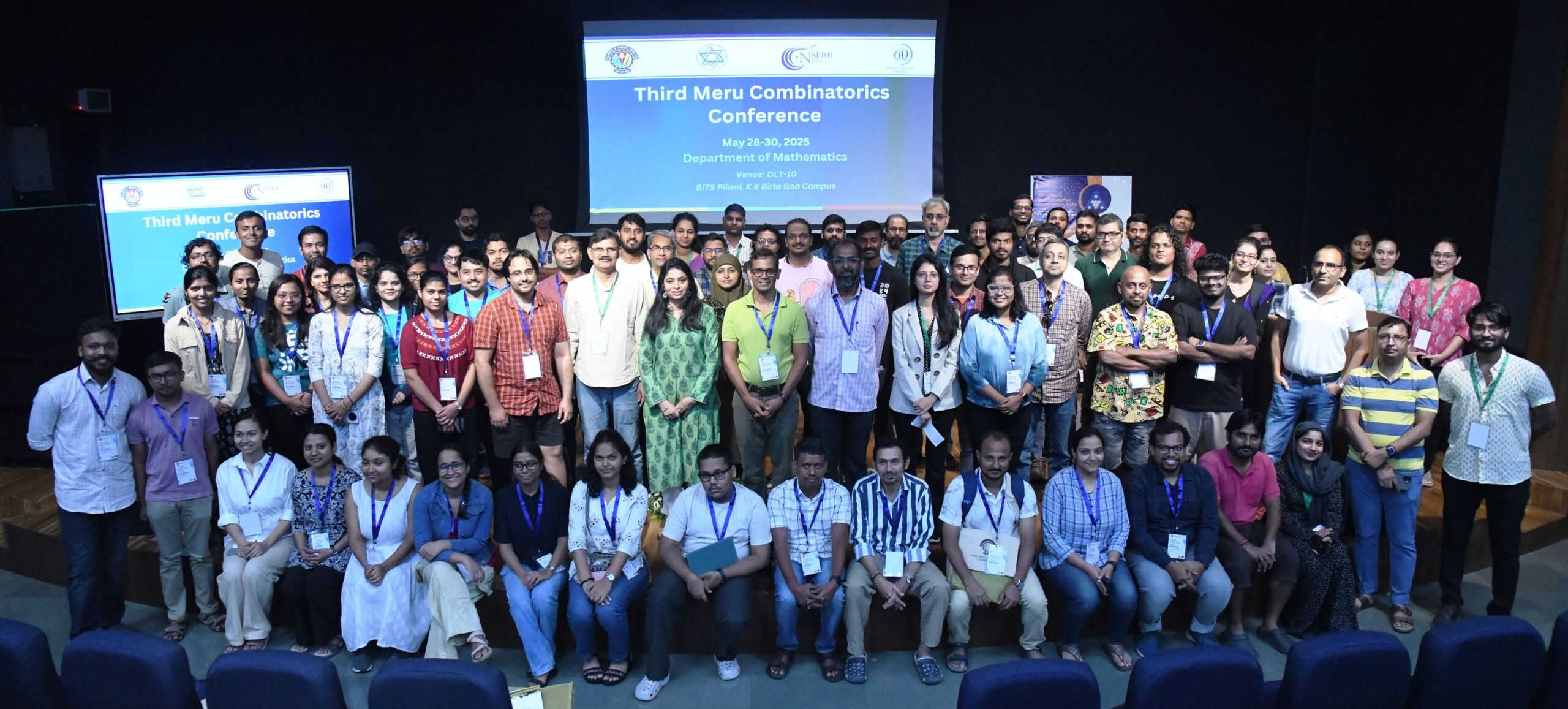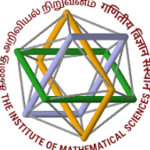Third Meru Combinatorics Conference 2025
28th – 30th May, 2025
Department of Mathematics
BITS Pilani, K K Birla, Goa Campus

This is the third of a series of annual conferences on combinatorics in India: the Meru Annual Combinatorics Conference. The series features a format that includes two in-depth minicourses on topics in combinatorics (broadly interpreted), alongside contributed talks and poster presentations.
Past Meru Combinatorics Conferences: First Meru Combinatorics Conference 2023, Second Meru Combinatorics Conference 2024.
Meru stands for the mountain in Indian mythology and was used as a metaphor for the triangle of binomial coefficients studied by classical Indian prosodists.
Dates: 28th to 30th May, 2025
Venue: Department of Mathematics, BITS Pilani, K K Birla Goa Campus, Goa, India
On-Campus Accommodation: Check-in date: 27th May 2025, Check-out date: 31st May 2025

Venue: DLT 10
| Time | Day 1 (May 28) |
Day 2 (May 29) |
Day 3 (May 30) |
|---|---|---|---|
| 08:00 – 09:00 | Registration | ||
| 09:00 – 09:30 |
Welcome & Opening Remarks DLT 9 |
||
| 09:30 – 11:00 |
Minicourse I: Part 1 M K Srinivasan |
Minicourse I: Part 2 M K Srinivasan |
Minicourse I: Part 3 M K Srinivasan |
| Tea / Coffee Break | |||
| 11:15 – 12:45 | Contributed Talk: Session 1 | Contributed Talk: Session 3 | Contributed Talk: Session 4 |
| Hiranya K Dey | Nishu Kumari | Mohan Ravichandran | |
| Anurag Singh | Velmurugan S | Himanshu Chandrakar | |
| Rajat Adak | Sadhanandh V | Prafullkumar Tale | |
| Lunch Break | |||
| 14:00 – 15:30 |
Minicourse II: Part 1 Nishad Kothari |
Minicourse II: Part 2 Nishad Kothari |
Minicourse II: Part 3 Nishad Kothari |
| Tea / Coffee Break | |||
| 16:00 – 17:30 | Contributed Talk: Session 2 | Poster Session | Contributed Talk: Session 5 |
| Santhosh Raghul | Chaithra P | ||
| V Sathish Kumar | DLT 10 Lobby Area | S P Narayanan | |
| Moumanti Podder | Shraddha Srivastava | ||
| 17:30 – 17:45 | Day 1 Ends | Day 2 Ends | Valedictory Function |
| 19:30 – 22:00 | Conference Dinner (C Mess) | Conference Ends | |
Speakers
Minicourses

Murali K. Srinivasan
IIT Bombay
Two recent results on the projective geometry
Boolean algebra is the poset of subsets of a finite set and projective geometry is the poset of subspaces of a finite dimensional vector space over a finite field with q elements. We discuss q-analogs of two famous results (one bijective and one algebraic) on the Boolean algebra.1. The bracketing algorithm gives an explicit symmetric chain decomposition (SCD) of the Boolean algebra. Griggs showed (using network flows) the existence of a SCD of the projective geometry. Greene and Kleitman asked for an explicit construction. Bjorner asked whether the projective geometry has a SBD (symmetric Boolean decomposition) (more general than an SCD). The Greene-Kleitman problem was solved in a remarkable paper of Vogt and Voigt. We build on this paper and give an explicit SBD of the projective geometry. (Joint work with Jonathan Farley)2. The Terwilliger algebra of the hypercube (= Hasse diagram of the Boolean algebra) is one of the basic objects in algebraic graph theory. It is a natural problem to find its q-analog. This was solved recently in two papers, the first by Ghosh and Srinivasan, and the second by Terwilliger. If time permits, we shall discuss a possible connection between the two problems.

Nishad Kothari
IIT Madras
Perfect Matchings: theory and problems
Dedicated to beloved Professor Murty — that is, U S R Murty (23rd December 1940 - 13th May 2025)
The study of perfect matchings (and, more generally, of matchings) has played a central role not only in the development of graph theory, but also in the growth of various other areas of combinatorics such as polyhedral combinatorics, enumerative combinatorics, combinatorial optimization, etc. For most problems pertaining to perfect matchings, one may restrict attention to matching covered graphs — that is, those connected graphs wherein each edge participates in some perfect matching. Ergo, for more than half a century now, several researchers have invested in developing an extensive theory, and these efforts have culminated in the recently published book "Perfect Matchings: A Theory of Matching Covered Graphs" by Lucchesi and Murty. This minicourse is inspired by, and will be based on, their monograph.
The objectives of this minicouse are twofold: firstly, to introduce the participants to the salient features of the aforementioned theory — especially, the tight cut decomposition theory (including Lovász's Uniqueness Theorem) and the ear decomposition theory (that drew inspiration from the well-known Whitney's Ear Decomposition Theorem); and secondly, to demonstrate their interplay towards solving various problems — most of which were major open problems back in the day. Time permitting, we will also discuss open problems as well as their special cases that are already solved.
Prerequisites for the Minicourse on Perfect Matchings: theory and problems
This advanced minicourse is intended for participants with prior exposure to graph theory. In particular, we recommend reviewing Module 5 (Matchings) from Dr. Nishad Kothari’s Structural Graph Theory course, available here. The module includes 11 video lectures (each approximately 50 minutes), freely available on YouTube.
After completing all 11 lectures, you may contact Dr. Kothari at nishad@cse.iitm.ac.in to request an assignment that can help you evaluate your understanding of the material.
Contributed Talks
Hiranya Kishore Dey (T1, Session 1, 28th May)
Some extremal problems on finite dimensional vector spaces over finite fields
Anurag Singh (T2, Session 1, 28th May)
Exploring the Influence of Graph Operations on Zero Forcing Sets
Rajat Adak (T3, Session 1, 28th May)
Localization of Extremal Graph Problems
G S Santhosh Raghul (T1, Session 2, 28th May)
λ-matchability in cubic graphs
V. Sathish Kumar (T2, Session 2, 28th May)
The branching models of Kwon and Sundaram via flagged hives
Moumanti Podder (T3, Session 2, 28th May)
Generalized percolation games on the infinite 2-dimensional square lattice
Nishu Kumari (T1, Session 3, 29th May)
Murnaghan--Nakayama rules for symplectic, orthogonal, and orthosymplectic Schur functions
Velmurugan S (T2, Session 3, 29th May)
On minimal polynomials of elements in symmetric and alternating groups
Sadhanandh Vishwanath (T3, Session 3, 29th May)
q-Character Polynomials and representations of FI category
Mohan Ravichandran (T1, Session 4, 30th May)
Interpolating between longest increasing and longest alternating sequences
Himanshu Chandrakar (T2, Session 4, 30th May)
Perfect Matching Complex of Polygonal Line Tiling
Prafullkumar Tale (T3, Session 4, 30th May)
Usual Structure, Unusual Results
Chaithra P (T1, Session 5, 30th May)
Partially commutative Lie superalgebras and marked multi-colorings
Sridhar Poojyam Narayanan (T2, Session 5, 30th May)
On spanning trees of Johnson graphs
Shraddha Srivastava (T3, Session 5, 30th May)
On iterated Induction-restriction for rook monoids and partition algebras
Posters
Poster Presentation Guideline: Participants presenting posters at the conference are requested to adhere to the following specifications.
-
Poster Size: A0 (approximately 33.1 inches wide × 46.8 inches tall)
-
Orientation: Portrait (vertical) only
-
Display Area: Poster boards available at the venue are 35 inches wide × 45 inches tall
Please ensure that your poster fits within these dimensions. Posters exceeding the board size or in landscape orientation may not be accommodated.
We look forward to your contributions and engaging poster sessions!
Saraswati Girish Nanoti (P1, Poster Session, 29th May)
A Little Aggression Goes a Long Way
Jharna Kalita (P2, Poster Session, 29th May)
A note on the maximum Aα-spectral radius of some classes of graphs
Aditya Singh Rana (P3, Poster Session, 29th May)
Walled-Brauer algebras for complex reflection groups
Guru Sharan N (P4, Poster Session, 29th May)
Rook decomposition of the partition function
Kavita Samant (P5, Poster Session, 29th May)
Spectral Bounds of the Generating Graph of ℤn
Sameeha Rehmani (P6, Poster Session, 29th May)
Square Graph of Finite Cyclic Group
Iswar Mahato (P7, Poster Session, 29th May)
A generalized class of matrices associated to threshold and chain graphs
Umesh Shankar (P8, Poster Session, 29th May)
Path representations of graphs
Papi Ray (P9, Poster Session, 29th May)
Forbidden subgraphs on conjugacy class graphs of groups
Sucharita Biswas (P10, Poster Session, 29th May)
On a family of quasi-strongly regular Cayley graphs
Pratiksha Chauhan (P11, Poster Session, 29th May)
Shellability of Cut Complexes of Powered Cycle Graphs
Sauvik Poddar (P12, Poster Session, 29th May)
Non-isomorphic d-integral circulant graphs
Digjoy Paul (P13, Poster Session, 29th May)
A new duality on Plane Trees and its applications in Catalan Combinatorics
Priyanka Vishwakarma (P14, Poster Session, 29th May)
Exploring Frugal Distinguishing and Determining Numbers of Certain Graph Families
Akankshya Sahu (P15, Poster Session, 29th May)
Path number of Levi graph
Committee
Organizing Committee
Convener: Dr. Yasmeen Akhtar, BITS Pilani - K K Birla Goa Campus
Co-conveners: Prof. Arvind Ayyer, IISc
Prof. Amritanshu Prasad, IMSc
Chief Patron:
Prof. V. Ramgopal Rao (VC, BITS Pilani)
Patron:
Prof. Suman Kundu (Director, BITS Pilani, K K Birla Goa Campus)
Scientific Advisory Committee
Prof. Arvind Ayyer, IISc
Prof. N. Narayanan, IIT Madras
Prof. Amritanshu Prasad, IMSc
Prof. S. Sivaramakrishnan, IIT Bombay
Local Organizing Committee
Dr. Yasmeen Akhtar, BITS Pilani, K K Birla Goa Campus
Dr. Mukesh K. Nagar, BITS Pilani, K K Birla Goa Campus
Prof. Tarkeshwar Singh, BITS Pilani, K K Birla Goa Campus
Prof. Prasanna K. Nekkare, HOD Mathematics, BITS Pilani, K K Birla Goa Campus
Event Support Team
Ms. Arfa Peerzade, BITS Pilani, K K Birla Goa Campus
Mr. Siddhant Naik, BITS Pilani, K K Birla Goa Campus
Ms. Shivani Tushar Parab, BITS Pilani, K K Birla Goa Campus
Ms. Raina Mary Thomas, BITS Pilani, K K Birla Goa Campus
Mr. Darshan Shanbhag, BITS Pilani, K K Birla Goa Campus
Important Dates
-
Registration & Abstract Submission Deadline: 15th February 2025
-
Notification of Acceptance: Selected participants have been notified via email.
-
Last Date for Payment of Registration Fee: 5th April 2025
-
Conference Dates: 28-30 May 2025
-
Conference Dinner: 29th May 2025
Registration & Abstract Submission (Closed)
Registration Fee:
-
Regular: INR 5000
-
Students and Postdoctoral Researcher: INR 2000
Registration Fee Payment: The payment link, along with the instructions, has been shared with the selected participants via email.
Participants
Aditya Singh Rana, IIT Dharwad
Akankshya Sahu, BITS Pilani, Hyderabad Campus
Amritanshu Prasad, IMSc
Anubhav Tripathi, Ahmedabad University
Anurag Singh, IIT Bhilai
Arundhati Rakshit, TCG-CREST
Arvind Ayyer, IISc
Brahadeesh Sankarnarayanan, IIT Bombay
Chaithra P, IISc
Darshan Shanbhag, BITS Pilani, Goa Campus
Dibyendu Biswas, CMI
Dipnit Biswas, IMSc
Digjoy Paul, IISc
G. Arunkumar, IIT Madras
G S Santhosh Raghul, IIT Madra
Gaurav Bhatnagar, NA
Guru Sharan N, IIT Gandhinagar
Harikrishnan T R, IMSc
Himanshu Chandrakar, IIT Bhilai
Hiranya Kishore Dey, IISc
Iswar Mahato, IIT Bombay
Jerisha U S, IIT Madras
Jharna Kalita, Tezpur University
Kavita Samant, Shiv Nadar Institution of Eminence
Krishnan Sivasubramanian, IIT Bomay
Koustav Mallik, ISI Kolkata
Mohan Ravichandran, Zessta Software Services
Moumanti Podder, IISER Pune
Narayanan N, IIT Madras
Niranjan Balachandran, IIT Bombay
Nishu Kumari, University of Vienna
Papi Ray, IIT Kanpur
Prafullkumar Tale, IISER Pune
Pragya Verma, IIT Bombay
Pratiksha Chauhan, IIT Mandi
Priyanka Magar, IIT Madras
Priyanka Vishwakarma, BITS Pilani, Hyderabad Campus
Puja Samanta, IIT Madras
R. Ganeshbabu, IIT Madras
Raina Mary Thomas, BITS Pilani, Goa Campus
Rahul K P, IIT Madras
Rajat Adak, IISc
Rutuja Vilas Sawant, CMI
Sadhanandh Vishwanath, CMI
Sagar Sawant, CMI
Sajith P., BITS Pilani, Hyderabad Campus
Sameeha Rehmani, Sullamussalam Science College Areekode
Saraswati Girish Nanoti, IIT Gandhinagar
Sauvik Poddar, Presidency University, Kolkata
Shalu Kumari, IIT Madras
Shivani Tushar Parab, BITS Pilani, Goa Campus
Shraddha Srivastava, IIT Dharwad
Shuchita Goyal, BITS Pilani, Pilani Campus
Siddhant Naik, BITS Pilani, Goa Campus
Sridhar Poojyam Narayanan, TIFR Mumbai
Subhajit Ghosh, IIT Madras
Sucharita Barik, TCG-CREST
Sucharita Biswas, Presidency University Kolkata
Tirtharaj Basu, IMSc
Umesh Shankar, IIT Bombay
V. Sathish Kumar, HRI
Velmurugan S, IMSc
Venue
How to reach the venue?
Being a popular tourist destination and a haven for relaxation, Goa offers superb connectivity to major cities throughout the country. Nesting in the lap of verdant hills, overlooking the Zuari River, BITS, Pilani K K Birla Goa Campus is spread over an area of 180 acres. The location of the campus is unique with respect to scenic beauty and panoramic view of picturesque surroundings encompassing the Zuari River, hillocks, waterways, forests, and landscape.
Note: BITS Pilani K K Birla Goa Campus is on the side of a bypass road to NH17B, and regular buses will not go via Campus, so avoid taking a local/ city bus.
Accessing BITS Pilani Goa Campus is facilitated through diverse transportation options, guaranteeing convenience for both attendees and visitors.
Air Travel
Goa boasts two airports, namely Goa Dabolim International Airport (GOI), situated approximately 5 km away and Manohar International Airport (Mopa, GOX), which is roughly at a distance of 55 km from BITS Pilani K K Birla Goa campus, the venue for the symposium. Goa International Airport, being the closest, is extensively connected to major cities across India, providing a time-efficient air travel option. One can find regular flights to this tropical paradise from cities like New Delhi, Mumbai, Bengaluru, Hyderabad, Kochi, and Chennai. The fastest way to reach Goa is often by taking a flight from Mumbai or Bengaluru, with the journey typically lasting around an hour. Air India is recognized as the national carrier. However, travelers can choose among various airlines, including SpiceJet, IndiGo, Air Asia, Akasa Air and Vistara. Upon arrival, pre-paid taxis are readily available to reach the Campus.
Pre-paid Taxi service at the Airports
Pre-paid Taxi counters are available at the airport arrival area.
Goa International Airport (Dabolim) to BITS Pilani K K Birla Goa Campus: ~Rs. 500/-
Manohar International Airport (Mopa) to BITS Pilani K K Birla Goa Campus: ~Rs. 3,000/-
One can also avail the ‘Goa Miles’ cab service via the Government certified transportation portal: https://www.goamiles.com.
Note: The rates may vary accordingly and can be higher if not pre-paid. The above rates and information are representative and approximate. Organizers are not responsible for any deviation in prices and information mentioned above.
Rail Travel
Those inclined towards rail travel can commute by train and arrive at Karmali Railway Station, located about 20 km, Madgaon railway station, which is 22 km away or Vasco railway station which is 10 km from BITS Pilani K K Birla Goa Campus. These railway stations have established connections to major cities in the region.
Karmali Railway Station to BITS Pilani K K Birla Goa Campus: ~Rs. 2,000/-
Madgaon Railway Station to BITS Pilani K K Birla Goa Campus: ~Rs. 2,500/-
Note: The above rates and information are representative and approximate. Organizers are not responsible for any deviation in prices and information mentioned above.
Road Travel
The campus is easily reachable by road, with well-maintained highways and road networks linking it to neighboring towns and cities like Mumbai, Bangalore, Pune, Hyderabad etc.
Accommodation Details
-
On-Campus Accommodation: On-campus accommodation for the participants in the hostel and guest house. The check-in date is 27th May and the check-out date is 31st May 2025. For any queries related to the accommodation, please contact Dr. Mukesh Kumar Nagar.
-
Nearby Hotels: Goa, a renowned tourist destination, offers a variety of accommodation options. You can click here to explore nearby choices and arrange your own accommodation.





